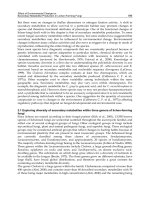Theoretical Perspectives on Global Stratification
Bạn đang xem bản rút gọn của tài liệu. Xem và tải ngay bản đầy đủ của tài liệu tại đây (92.61 KB, 5 trang )
Theoretical Perspectives on Global Stratification
Theoretical Perspectives on
Global Stratification
Bởi:
OpenStaxCollege
As with any social issue, global or otherwise, there are a variety of theories that
scholars develop to study the topic. The two most widely applied perspectives on global
stratification are modernization theory and dependency theory.
Modernization Theory
According to modernization theory, low-income countries are affected by their lack of
industrialization and can improve their global economic standing through:
1. an adjustment of cultural values and attitudes to work
2. industrialization and other forms of economic growth (Armer and Katsillis
2010)
Critics point out the inherent ethnocentric bias of this theory. It supposes all countries
have the same resources and are capable of following the same path. In addition, it
assumes that the goal of all countries is to be as “developed” as possible. There is no
room within this theory for the possibility that industrialization and technology are not
the best goals.
There is, of course, some basis for this assumption. Data show that core nations tend
to have lower maternal and child mortality rates, longer life spans, and less absolute
poverty. It is also true that in the poorest countries, millions of people die from the
lack of clean drinking water and sanitation facilities, which are benefits most of us
take for granted. At the same time, the issue is more complex than the numbers might
suggest. Cultural equality, history, community, and local traditions are all at risk as
modernization pushes into peripheral countries. The challenge, then, is to allow the
benefits of modernization while maintaining a cultural sensitivity to what already exists.
1/5
Theoretical Perspectives on Global Stratification
Dependency Theory
Dependency theory was created in part as a response to the western-centric mindset of
modernization theory. It states that global inequality is primarily caused by core nations
(or high-income nations) exploiting semi-peripheral and peripheral nations (or middleincome and low-income nations), creating a cycle of dependence (Hendricks 2010).
As long as peripheral nations are dependent on core nations for economic stimulus
and access to a larger piece of the global economy, they will never achieve stable and
consistent economic growth. Further, the theory states that since core nations, as well
as the World Bank, choose which countries to make loans to, and for what they will
loan funds, they are creating highly segmented labor markets that are built to benefit the
dominant market countries.
At first glance, it seems this theory ignores the formerly low-income nations that are
now considered middle-income nations and are on their way to becoming high-income
nations and major players in the global economy, such as China. But some dependency
theorists would state that it is in the best interests of core nations to ensure the longterm usefulness of their peripheral and semi-peripheral partners. Following that theory,
sociologists have found that entities are more likely to outsource a significant portion
of a company’s work if they are the dominant player in the equation; in other words,
companies want to see their partner countries healthy enough to provide work, but not
so healthy as to establish a threat (Caniels and Roeleveld 2009).
Factory Girls
We’ve examined functionalist and conflict theorist perspectives on global inequality, as
well as modernization and dependency theories. How might a symbolic interactionist
approach this topic?
The book Factory Girls: From Village to City in Changing China, by Leslie T. Chang,
provides this opportunity. Chang follows two young women (Min and Chunming)
employed at a handbag plant. They help manufacture coveted purses and bags for the
global market. As part of the growing population of young people who are leaving
behind the homesteads and farms of rural China, these female factory workers are ready
to enter the urban fray and pursue an ambitious income.
Although Chang’s study is based in a town many have never heard of (Dongguan),
this city produces one-third of all shoes on the planet (Nike and Reebok are major
manufacturers here) and 30 percent of the world’s computer disk drives, in addition to a
plethora of apparel (Chang 2008).
But Chang’s focus is less centered on this global phenomenon on a large scale, and more
concerned with how it affects these two women. As a symbolic interactionist would do,
2/5
Theoretical Perspectives on Global Stratification
Chang examines the daily lives and interactions of Min and Chunming—their workplace
friendships, family relations, gadgets and goods—in this evolving global space where
young women can leave tradition behind and fashion their own futures. Their story is
one that all people, not just scholars, can learn from as we contemplate sociological
issues like global economies, cultural traditions and innovations, and opportunities for
women in the workforce.
Summary
Modernization theory and dependency theory are two of the most common lenses
sociologists use when looking at the issues of global inequality. Modernization theory
posits that countries go through evolutionary stages and that industrialization and
improved technology are the keys to forward movement. Dependency theory, on the
other hand, sees modernization theory as Eurocentric and patronizing. With this theory,
global inequality is the result of core nations creating a cycle of dependence by
exploiting resources and labor in peripheral and semi-peripheral countries.
Section Quiz
One flaw in dependency theory is the unwillingness to recognize _______.
1. that previously low-income nations such as China have successfully developed
their economies and can no longer be classified as dependent on core nations
2. that previously high-income nations such as China have been economically
overpowered by low-income nations entering the global marketplace
3. that countries such as China are growing more dependent on core nations
4. that countries such as China do not necessarily want to be more like core
nations
Answer
A
One flaw in modernization theory is the unwillingness to recognize _________.
1. that semi-peripheral nations are incapable of industrializing
2. that peripheral nations prevent semi-peripheral nations from entering the global
market
3. its inherent ethnocentric bias
4. the importance of semi-peripheral nations industrializing
Answer
C
3/5
Theoretical Perspectives on Global Stratification
If a sociologist says that nations evolve towards more advanced technology and more
complex industry as their citizens learn cultural values that celebrate hard work and
success, she is using _______ theory to study the global economy.
1. modernization theory
2. dependency theory
3. modern dependency theory
4. evolutionary dependency theory
Answer
A
If a sociologist points out that core nations dominate the global economy, in part by
creating global interest rates and international tariffs that will inevitably favor highincome nations over low-income nations, he is a:
1. functionalist
2. dependency theorist
3. modernization theorist
4. symbolic interactionist
Answer
B
Dependency theorists explain global inequality and global stratification by focusing on
the way that:
1. core nations and peripheral nations exploit semi-peripheral nations
2. semi-peripheral nations exploit core nations
3. peripheral nations exploit core nations
4. core nations exploit peripheral nations
Answer
D
Short Answer
There is much criticism that modernization theory is Eurocentric. Do you think
dependency theory is also biased? Why or why not?
Compare and contrast modernization theory and dependency theory. Which do you
think is more useful for explaining global inequality? Explain, using examples.
4/5
Theoretical Perspectives on Global Stratification
Further Research
For more information about economic modernization, check the Hudson Institute at
Learn more about economic dependency at the University of Texas Inequality Project:
References
Armer, J. Michael and John Katsillis. 2010. “Modernization Theory.” Encyclopedia of
Sociology, edited by E. F. Borgatta. Retrieved January 5, 2012 ( />Chapters/3%20theories%20of%20sociology/11%20modernization%20theory.htm).
Caniels, Marjolein, C.J. Roeleveld, and Adriaan Roeleveld. 2009. “Power and
Dependence Perspectives on Outsourcing Decisions.” European Management Journal
27:402–417. Retrieved January 4, 2012 ( />Papers/645947/Power_and_dependence_perspectives_on_outsourcing_decisions).
Chang, Leslie T. 2008. Factory Girls: From Village to City in Changing China. New
York: Random House.
Hendricks, John. 2010. “Dependency Theory.” Encyclopedia of Sociology, edited by
E.F. Borgatta. Retrieved January 5, 2012 ( />3%20theories%20of%20sociology/5%20dependency%20theory.htm).
5/5









